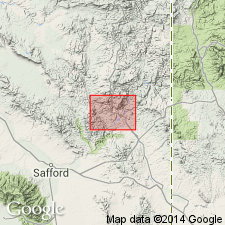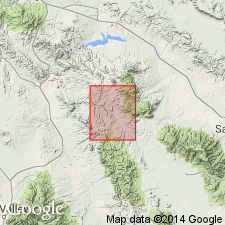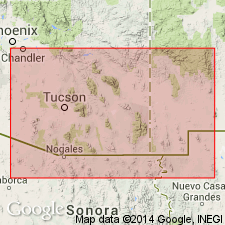
- Usage in publication:
-
- Pinkard formation*
- Modifications:
-
- Named
- Biostratigraphic dating
- Dominant lithology:
-
- Sandstone
- Shale
- AAPG geologic province:
-
- Basin-and-Range province
Summary:
Named presumably for Pinkard Gulch, 2 mi west of Morenci, AZ No type locality designated. Best exposures are in Silver Basin Creek, 2 mi southwest of Morenci, Greenlee Co, AZ in Basin-and-Range province. Consists of green, brown, black, reddish shales, and quartzitic sandstones. The total thickness is difficult to measure but 175 ft measured southwest of Morenci smelter. Unconformably overlies Modoc limestone (new) of Mississippian age. Contains fossils that are characteristic of the Colorado group. Is Cretaceous. Fossil bivalves.
Source: GNU records (USGS DDS-6; Denver GNULEX).

- Usage in publication:
-
- Pinkard Formation*
- Modifications:
-
- Areal extent
- AAPG geologic province:
-
- Basin-and-Range province
Summary:
A name from the Morenci area extended into the report area where it crops out over 1.5 sq mi. Rests unconformably on Horquilla and on Escabrosa Limestones. Intruded by Goodwin Canyon Quartz Monzonite (new) and by Copper Creek Granodiorite (new). Overlain by Williamson Canyon Volcanics (new) and Galiuro Volcanics. Disrupted by many faults. Exposures are poor. Is 900+ ft thick. Molluscan and coral fauna identified. Of Late Cretaceous age.
Source: GNU records (USGS DDS-6; Denver GNULEX).

- Usage in publication:
-
- Pinkard Formation*
- Modifications:
-
- Overview
- AAPG geologic province:
-
- Basin-and-Range province
Summary:
Is oldest Cretaceous formation at Morenci, Greenlee Co, AZ in Basin-and-Range province. Overlies Mississippian limestone with erosional unconformity; unconformably overlain by Tertiary rocks. Is considered equivalent to the unnamed lower sedimentary unit of Willden (1964) in Deer Creek area east of Christmas, Gila Co, AZ. In Aravaipa area, Graham Co, AZ, rocks referred by Simons (1964) to the Pinkard Formation are intermediate in lithologic character between Pinkard in Morenci area and the lower sedimentary unit in Christmas area; and are overlain unconformably by Williamson Canyon Volcanics of Late Cretaceous and (or) Tertiary age. Is shown to be correlative with lower part of Colorado Formation in Silver City-Santa Rita area, NM. Chiefly of shallow-water marine origin but includes some continental coastal-plain and lagoonal sediments. Pinkard and Colorado are distinctly different in lithology from any Cretaceous strata farther south in southeastern AZ and probably have no age equivalents there; apparently represent rocks near southwestern wedge edge of thick Upper Cretaceous sequence of western interior of North America with little relation to rocks farther south. Marine fossils indicate a Cenomanian and Turonian (early Late Cretaceous) age.
Source: GNU records (USGS DDS-6; Denver GNULEX).
For more information, please contact Nancy Stamm, Geologic Names Committee Secretary.
Asterisk (*) indicates published by U.S. Geological Survey authors.
"No current usage" (†) implies that a name has been abandoned or has fallen into disuse. Former usage and, if known, replacement name given in parentheses ( ).
Slash (/) indicates name conflicts with nomenclatural guidelines (CSN, 1933; ACSN, 1961, 1970; NACSN, 1983, 2005, 2021). May be explained within brackets ([ ]).

